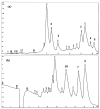The effect of the aerial part of Lindera akoensis on lipopolysaccharides (LPS)-induced nitric oxide production in RAW264.7 cells
- PMID: 23624606
- PMCID: PMC3676778
- DOI: 10.3390/ijms14059168
The effect of the aerial part of Lindera akoensis on lipopolysaccharides (LPS)-induced nitric oxide production in RAW264.7 cells
Abstract
Four new secondary metabolites, 3α-((E)-Dodec-1-enyl)-4β-hydroxy-5β-methyldihydrofuran-2-one (1), linderinol (6), 4'-O-methylkaempferol 3-O-α-L-(4''-E-p-coumaroyl)rhamnoside (11) and kaempferol 3-O-α-L-(4''-Z-p-coumaroyl)rhamnoside (12) with eleven known compounds-3-epilistenolide D1 (2), 3-epilistenolide D2 (3), (3Z,4α,5β)-3-(dodec-11-ynylidene)-4-hydroxy-5-methylbutanolide (4), (3E,4β,5β)-3-(dodec-11-ynylidene)-4-hydroxy-5-methylbutanolide (5), matairesinol (7), syringaresinol (8), (+)-pinoresinol (9), salicifoliol (10), 4''-p-coumaroylafzelin (13), catechin (14) and epicatechin (15)-were first isolated from the aerial part of Lindera akoensis. Their structures were determined by detailed analysis of 1D- and 2D-NMR spectroscopic data. All of the compounds isolated from Lindera akoensis showed that in vitro anti-inflammatory activity decreases the LPS-stimulated production of nitric oxide (NO) in RAW 264.7 cell, with IC50 values of 4.1-413.8 µM.
Figures
References
-
- Chen C.C., Lin C.F., Huang Y.L. Bioactive constituents from the flower buds and peduncles of Lindera megaphylla. J. Nat. Prod. 1995;9:1423–1425.
-
- Chang Y.C., Chen C.Y., Chang F.R., Wu Y.C. Alkaloids from Lindera glauca. J. Chin. Chem. Soc. 2001;48:811–815.
-
- Cheng X.L., Ma S.C., Wei F., Wang G.L., Xiao X.Y., Lin R.C. A new sesquiterpene isolated from Lindera aggregata (SIMS) KOSTERM. Chem. Pharm. Bull. 2007;55:1390–1392. - PubMed
-
- Takamasa O., Akito N., Munehiro N., Makoto I., Li Y.M., Shinya M., Hajime M., Hisayoshi F. New sesquiterpene lactones from water extract of the root of Lindera strychnifolia with cytotoxicity against the human small cell cancer, SBC-3. Tetrahedron. Lett. 2005;46:8657–8660.
-
- Kouni I., Hirai A., Fukushige A., Jiang Z.H., Takashi T. New eudesmane sesquiterpenes from the root of Lindera strychnifolia. J. Nat. Prod. 2001;64:286–288. - PubMed
Publication types
MeSH terms
Substances
LinkOut - more resources
Full Text Sources
Other Literature Sources




